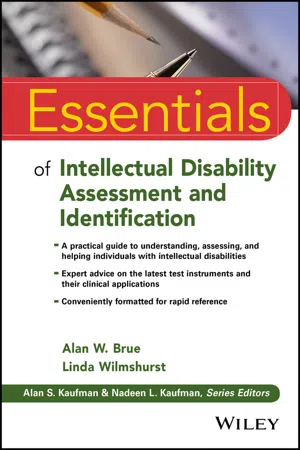
Essentials of Intellectual Disability Assessment and Identification
- English
- ePUB (mobile friendly)
- Available on iOS & Android
Essentials of Intellectual Disability Assessment and Identification
About This Book
Brue's Essentials Intellectual Disability is a concise, up-to-date overview of intellectual disability evaluation and assessment. This text offers a practical, concise overview of the nature of intellectual disability and adaptive skills functioning in children, adolescents, and adults. Coverage includes the latest information on prevalence, causes, differential diagnoses, behavioral and social concerns, test instruments, and the new DSM-5 diagnostic criteria. The discussion promotes a deeper understanding of the use of assessment data to inform interventions in clinical practice.
Designed for easy navigation, each chapter highlights important points and key cautions to allow quick reference without sacrificing depth. A sample assessment report illustrates how findings should be communicated to better inform treatment, giving you a practical reference to ensure comprehensive reporting. In 2013, the DSM-5 conceptualization of intellectual disabilities was significantly changed. It's important for professionals to have access to the most current guidelines from a variety of sources, and this book compiles them all into a single reference.
Frequently asked questions
Information
Chapter One
History of Intellectual Disability
Early Beginnings
Rapid Reference 1.1: A Historical Look at Intellectual Disabilities
- 1838 Jean Esquirol publishes a manuscript which contains a large section devoted to determining the difference between idiocy and mentally deranged persons.
- 1876 Seguin becomes the founding father of AAMR.
- 1905 The Binet Simon, published in France, becomes the first instrument to assess intelligence.
- 1910 AAMR publishes the first system of classification for MR. Henry Goddard, director of research at the Vineland Training School, publishes an American version of the Binet Simon.
- 1916 Terman renames the Binet-Simon the Stanford Binet and revises how intelligence is derived using the intelligence quotient (IQ).
- 1935 Edgar Doll publishes the Vineland Social Maturity Scale.
- 1952 DSM–I (American Psychiatric Association [APA]) introduces the classification category of mental deficiency for cases primarily presenting as a defect in intelligence. The category contains three levels of severity: mild, moderate, and severe.
- 1959 AAMR announces three criteria for establishing MR: low IQ (less than 85), impaired adaptive behavior, and onset before age 16. Five levels of severity are suggested: borderline, mild, moderate, severe, and profound.
- 1968 DSM–II (APA) changes the name from “mental deficiency” to “mental retardation” and adopts the five levels of severity suggested by the AAMR. Criteria are low IQ (less than 85), impaired adaptive skills, and onset during the developmental period.
- 1971 In Wyatt v. Stickney, a landmark class action suit in Alabama, Judge Johnson rules that individuals confined to residential centers have a right to treatment.
- 1975 Public Law 94-142: Rights of all children with disabilities to have a free and appropriate education. The law, The Education of all Handicapped Children Act (EHA), provides state grants for the provision of services for children with disabilities.
- 1979 As a result of the class action lawsuit Larry P. v. Riles, all California school districts were barred from using IQ tests as the sole means of determining placement of African American children in classes for the educable mentally retarded.
- 1980 DSM–III (APA) reduced “subnormal” intelligence from an IQ of 85 (I standard deviation [SD] below the mean) to an IQ of 70 (2 SDs below the mean).
- 1990 EHA is revised and renamed the Individuals with Disabilities Education Act (IDEA).
- 1992 AAMR releases the revision of its manual replacing levels of severity of MR with patterns and intensity of supports needed: intermittent, limited, extensive, and pervasive.
- 1994 DSM–IV (APA) retains the four levels of severity—mild, moderate, severe, profound—which are no longer comparable to AAMR criteria; however, it makes comparisons to the education system (e.g., “mild” is equivalent to “educable”; “moderate” is equivalent to “trainable”).
- 1997 IDEA is reauthorized.
- 2004 IDEA reauthorized and renamed the Individuals with Disabilities Education Improvement Act of 2004.
- 2007 AAMR changes its name to the American Association on Individuals with Intellectual and Developmental Disabilities (AAIDD).
- 2010 President Obama signs “Rosa's Law” on October 5.
- 2010 AAIDD publishes the most recent version, the 11th edition of AAIDD's Intellectual Disability: Definition, Classification, and Systems of Support (AAIDD, 2010).
- 2013 DSM–5 (APA) publishes the most recent criteria for intellectual disability in the section on Neurodevelopmental Disorders.
The Turn of the Century: 1900 to 1950
Table of contents
- Cover
- Title Page
- Copyright
- Table of Contents
- Dedication
- Series Preface
- Acknowledgments
- Chapter One: History of Intellectual Disability
- Chapter Two: Prevalence, Causes, Issues, and Comorbid Disorders
- Chapter Three: Current Intellectual Disability Diagnostic and Federal Education Criteria
- Chapter Four: Legal Issues and Concerns
- Chapter Five: Theories of Intelligence and the Flynn Effect
- Chapter Six: Assessment of an Intellectual Disability
- Chapter Seven: Integration of Assessment Results
- Chapter Eight: Postassessment Planning
- Appendix A: State Departments of Special Education
- Appendix B: AAIDD and The Arc Position Statement on the Criminal Justice System
- Appendix C: American Association on Intellectual and Developmental Disabilities (AAIDD): Guidelines to Professional Conduct
- Appendix D: The ARC Position Statement on Self-Determination
- Appendix E: AAIDD and The Arc Position Statement on Self-advocacy
- Appendix F: The ARC Position Statement on Education
- Appendix G: The ARC Position Statement on Employment
- Appendix H: Helpful Websites
- References
- About the Authors
- Index
- End User License Agreement